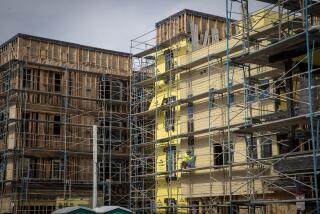Developers Required to Make Housing Fit Children : For Kids in Sweden, Safety at Home Is Built In
- Share via
STOCKHOLM — Playgrounds and indoor safety measures to protect small children are not something Swedish developers use as a sales pitch. They are the law.
“The planning and building of multifamily housing in Sweden has, during the whole post-World War II period, been aimed at enabling children to live there,” said Ake Daun, a housing researcher and a professor of ethnology at Stockholm University.
“For decades, apartment buildings, mostly in suburban developments, have been designed with a mixture of apartment sizes with the intention that all categories of people, such as families with children, retirees and singles, live in the same area.”
Playgrounds Provided
In efforts by the government of this welfare state of 8.3 million to guarantee that multifamily housing be suited for children, the building code has spelled out for the last decade that developers must provide playgrounds within 50 yards from front doors of apartment buildings.
A requirement that playgrounds be located in sunny areas resulted from the tendency of developers to give the nice sides of buildings to parking rather than to facilities for children, said Hans Ornhall of the National Swedish Board of Physical Planning and Building.
Another demand is that material underneath swings and jungle gyms be designed to prevent accidents, ruling out concrete. Swings often are equipped with low fences around them to prevent smaller children from walking into them, though that precaution is just a government recommendation.
The building code also stipulates that a sandbox be allotted for every 30 apartments that are two-bedroom or larger, whereas in new single-family housing areas there is a requirement that children have common ground for play within 160 yards of each home, even if it is only a plain outdoor area, Ornhall said.
“There is a basic standard here in children’s outdoor environment with playgrounds that is very good in an international perspective,” said Louise Gaunt, an architect of the National Swedish Institute for Building Research.
“But that does not mean we do not still see shortcomings. From here, to make it stimulating, exciting and imaginative is a big step. No building codes in the world could ensure that, but it is up to the developers and owners.”
Bjorn Cederquist, an expert on children’s environments at the Swedish Board of Health and Welfare, said he thinks that Swedes, in trying to eliminate accidents to children, have regulated so extensively that “with the best of intentions, anything that could give children experiences, especially unexpected ones, are weeded out.”
“There are even recommendations on what kind of sand is suitable in the sandbox. It is very fine in order not to be dangerous to swallow, but at the same time it will not make too much dust or turn into clay and make them dirty. So, it is impossible to sculpture a castle like one can on the beach and that is just one of the harmless aesthetic experiences one cannot have in a Swedish playground,” Cederquist said.
Homes must also be equipped with an array of safety measures for small children, if built or redone since the mid-1970s, according to the building code. Standard devices include a guard covering the front and sides of the stove to keep small hands away from hot pots, and child-proof handles on windows.
The electric outlets of 220 volts--twice the power in most U.S. homes--are shuttered under the code, making it very difficult for a child to insert a metallic object.
As a result of the measures, Sweden has the best statistics on child accidents in the Western world , Gaunt said.
More to Read
Sign up for Essential California
The most important California stories and recommendations in your inbox every morning.
You may occasionally receive promotional content from the Los Angeles Times.








